Motorola and Verizon Wireless announced one of two expected high-end successors to the popular Motorola Droid phone.
Running Android 2.1 (and soon 2.2) on a 1GHz TI OMAP processor, the Droid X has a 4.3-inch display with 854 x 480 resolution, an eight-megapixel camera, 8GB of flash plus a 16GB microSD card, and 3G mobile hotspot functionality, say the companies.
The Droid X will be available on Verizon’s 3G network on July 15, Motorola and Verizon said. A no-show at the companies’ launch event, however, was the Droid 2, which had been tipped by various sites in recent weeks under names including the Shadow and Droid Xtreme.
According to a recent story by Android, the Droid 2 is essentially the same phone as the Droid X except with a slide-out keyboard, and is likely to ship shortly after the Droid X. Meanwhile, later in the year a 2GHz Motorola Android phone will arrive, Motorola previously announced.
The Droid X offers a 1GHz Texas Instruments OMAP system-on-chip (SoC), enabling the phone to play and record 720p video at 30 frames per second (fps), according to Verizon. Android identified the processor as TI’s ARM Cortex-A8-based OMAP3630, as had been previously tipped.
The OMAP3630 is a die-shrunk, 45nm fabricated version of the 65nm, 550MHz OMAP3430 SoC, which graced the hugely popular Motorola Droid. The OMAP3630 debuted as a 720MHz processor, but has apparently since been upped to 1GHz.
According to benchmarks of a phone claimed by Android to be the almost identical Droid 2 , the phone scored 1,199 on the Quadrant system benchmark, compared to 373 for the original Droid. GPU (graphics processing unit) benchmarks showed a doubling of the frames per second. The testers found this surprising, since all three of Motorola’s Droids are said to have the same GPU.
Motorola did not offer internal RAM specs, but says that the Droid supplies a generous allotment of 8GB of onboard flash, as well as a 16GB SD card, for a total of 24GB flash memory. This is upgradable to 40GB if users opt for the 32GB data card, says the company.
The 4.3-inch capacitive touchscreen offers 854 x 480 resolution and pinch-to-zoom, identical to Sprint’s high-end 1GHz Snapdragon-based HTC Evo 4G. The display is considerably larger than the 3.7-inch display on the original Droid, which offered the same resolution.
Supporting Verizon’s CDMA 800/1900, EVDO rev. A 3G network, the Droid X also supplies 802.11n, Bluetooth 2.1, and aGPS wireless capabilities, says Motorola. A mini-HDMI port, microUSB port, 3.5mm headset jack, accelerometer, and proximity, ambient light, and eCompass sensors are also said to provided.
Measuring 5.0 x 2.6 x 0.4 inches (127.5 x 65.5 x 9.9mm), the phone is taller and wider than the first Droid, which measured 4.6 x 2.4 x 0.5 inches (115.8 x 60 x 13.7mm), but also thinner. The phone has dropped a bit of weight, too, weighing in at 5.47 ounces (155 grams) instead of the original Droid’s six ounces (169 grams). The Droid X offers a removable 1540 mAh battery that offers eight hours of talk time and 220 hours of standby, says Motorola.
The Droid X is further equipped with a dual-LED flash, eight-megapixel camera, up from five megapixels on the original Droid. There is also an “HD camcorder,” says Verizon, though as far as we can see, this is not a separate front-facing camcorder, but a capability of the main camera.
The autofocus camera provides a mechanical shutter with 1/1000 shutter speed, image stabilization, and 16:9 image capture, says the company. Video capabilities are said to include slow-motion and fast-motion capture modes, as well as an LED spotlight.
In addition, the phone is said to provide a three-microphone multi-directional audio recording feature, as well as directional audio capture. The Droid X also offers DLNA support to “download, stream and share personal HD content,” says the mobile carrier.
The Droid X ships with 3G mobile hotspot functionality, allowing its broadband connection to be shared with as many as five Wi-Fi devices, according to Verizon. (For the record, the Evo 4G’s hotspot is claimed to support up to eight simultaneous users.) To activate the hotspot feature, users will need to pony up $20 a month.
Features and specifications listed by Motorola for the Droid X include:
* Processor — n/s, but said to be 1GHz Texas Instruments OMAP3630
* Memory — up to 8GB of flash, plus microSD slot that accepts up to 32GB (16GB card bundled with unit)
* Display — 4.3-inch touchscreen with 854 x 480 pixel resolution
* Camera — 8 megapixel, with LED flash and autofocus; 720p 30fps video capture
* Networking:
o WAN — CDMA 800/1900MHz, EVDO Rev. A
o WLAN — 802.11n, with mobile hotspot functionality
o PAN — Bluetooth 2.1
o aGPS
* Other I/O:
o microUSB port
o 3.5mm headset jack
o mini-HDMI
* Other features — Accelerometer, proximity, ambient light, and eCompass sensors
* Battery — 1540mAh lithium-ion battery; up to 480 minutes of continuous usage and 220 hours of standby
* Dimensions — 5.01 x 2.61 x 0.38 inches (127.5 x 66.5 x 9.9mm)
* Weight — 5.46 ounces (155g)
On the software side, the phone will ship with Android 2.1, but “in the latter half of the summer” will receive an OTA upgrade to Android 2.2 and Adobe Flash Player 10.1, says Motorola. This will offer support for both Exchange and Gmail, providing push delivery of email and live widgets that stream messages to the home screen, says the company.
Motorola and Verizon appear to be aiming the Droid X at enterprise users, with other touted Android 2.2 features including a corporate directory, global look-up, “cloud to device messaging,” and the ability to filter widgets to differentiate work and home email. There is also said to be a unified calendar for Enterprise, as well as sync with Google Calendar. Security protocols allow remote password control and wipe via Exchange server, say the companies.
The Droid X can display up to eight simultaneous browser windows, and offers seven customizable home screens, says Verizon. Apps include Google apps such as Google Maps Navigation, Maps, Talk, Voice Search, YouTube, Latitude, Contact Sync, and Calendar. Swype text input is also said to be provided.
Meanwhile, Verizon is adding a new Blockbuster On Demand app, that will join Verizon’s V Cast Video apps. Other Verizon apps are said to include NFL Mobile, Skype mobile, and EA Need for Speed Shift.
There had been widespread speculation that the Droid X and/or Droid 2 would run a new verson of Motorola’s MotoBlur UI, called ShadowBlur or NinjaBlur, but the companies make no mention of it. MotoBlur runs on lower-end Motorola phones such as the Backflip, but did not appear on the original Droid.
Stated Sanjay Jha, co-chief executive officer of Motorola and chief executive officer of Motorola Mobile Devices and Home business, “Motorola designed Droid X to push the extreme limits of Android innovation, and enable you to do even more with your mobile device.”
Stated Andy Rubin, VP of engineering for Google, “It has been an exciting time for Android momentum and global consumer adoption since the announcement of Droid by Motorola nine months ago. There are 160,000 new Android-powered devices activated daily and Android Market has grown to over 65,000 applications. Plus later this summer, Verizon Wireless and Motorola will update all the Droid by Motorola phones to the latest 2.2 software.”
The Droid X by Motorola will be available on Verizon Wireless beginning July 15 for $200 after a $100 mail-in rebate with a new two-year customer agreement. The 3G Mobile Hotspot service is available for an additional $20 per month.

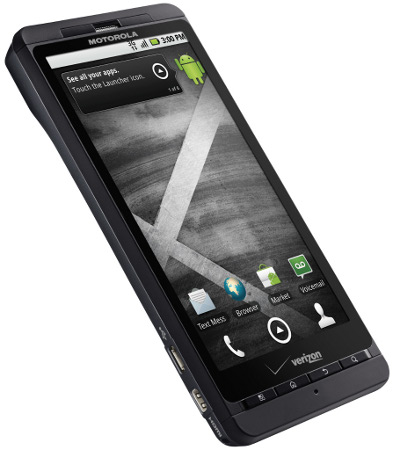
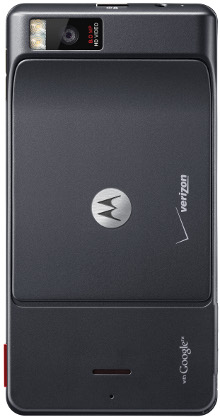


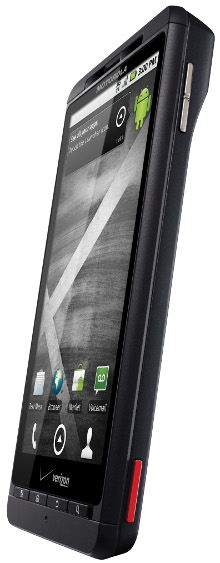
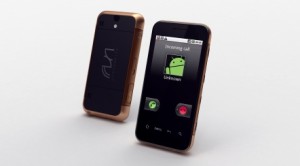
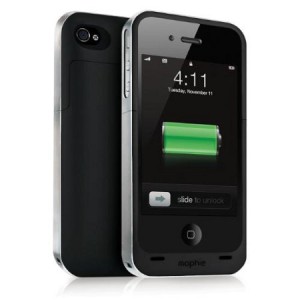

In LATE ! Because Samsung Galaxy S Second gen and Infuse 4G is surpassing. For the same price!